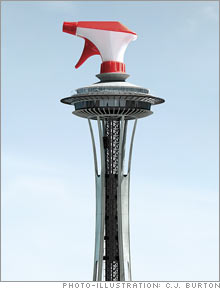Want a job at Google? Try these brainteasers firstGoogle, Microsoft, and eBay are looking for engineers who can think on their feet. Here's how they find them.(Business 2.0 Magazine) -- Dream of landing a coding job at an A-list tech company? It might be a good idea to prep for your interviews by pondering how many golf balls can fit inside a school bus. Or how much you would charge for washing all the windows in Seattle. Or why, exactly, manhole covers are round and not, say, square. Seemingly random questions like these have become commonplace in Silicon Valley and other tech outposts, where companies aren't as interested in the correct answer to a tough question as they are in how a prospective employee might try to solve it. Since businesses today have to be able to react quickly to shifting market dynamics, they want more than engineers with high IQs and good college transcripts. They want people who can think on their feet.    Microsoft (Charts, Fortune 500) often gets credit for bringing so-called open-ended logic-problem screening tools into vogue in the late 1980s, when Redmond interviewers peppered job candidates with offbeat questions like How much does a 747 weigh? "We want to gauge people's creativity," says Warren Ashton, recruiting manager at Microsoft. The manhole cover problem is Ashton's personal favorite. The most common answer, he says, is that a square manhole cover, tipped at an angle, could fall through the hole. "But some people recognize that you can roll a round manhole cover from site to site. Others figure that you save money by making it round because of tooling requirements. You want to see people taking their conclusions as far as possible." Such questions are more relevant to a high-tech job interview than you might think. "Employers want to see if you can make an estimate in the ballpark, within an order of magnitude," says Mark Jen, a former Google (Charts, Fortune 500) employee who is now a program manager at Tagged. Coders are constantly making educated guesses rather than calculating exact answers, so a good interview should probe how well a candidate handles such estimates. That's why Amazon.com (Charts, Fortune 500) interviewers, for example, have been known to ask job candidates to guess how many gas stations there are in the United States or to ballpark that bill for washing all of Seattle's windows. But today's interviews go beyond seat-of-the-pants estimation. Author, design consultant, and veteran coder Bruce Eckel likes to have job candidates describe a chicken using a programming language. eBay (Charts, Fortune 500) often hits candidates with a word problem that goes like this: You have five pirates, ranked from 5 to 1 in descending order. The top pirate has the right to propose how 100 gold coins should be divided among them. But the others get to vote on his plan, and if fewer than half agree with him, he gets killed. How should he allocate the gold in order to maximize his share but live to enjoy it? (Hint: One pirate ends up with 98 percent of the gold.) But no company has taken brainteaser recruiting quite as far as Google, which famously reeled in engineers three years ago by posting complex math problems on a billboard along Highway 101 in Silicon Valley. Passing motorists were invited to submit their solutions to an undisclosed website. (The site's URL was hidden in the answer.) If you got to the site, you were asked a second, more difficult question. If you answered that one correctly, you were invited to submit your resume. Once you got to the Googleplex for an interview, a favorite question was this: You are shrunk to the height of a nickel and your mass is proportionally reduced so as to maintain your original density. You are then thrown into an empty glass blender. The blades will start moving in 60 seconds. What do you do? It's not just employees who have to adjust to the new screening processes. Employers are also prepping for interviews in ways they never did before. When LinkedIn founder Reid Hoffman was searching for a new CEO earlier this year, he took an unusual approach to checking references. Having set his sights on a particular candidate, he used the LinkedIn network to find what he calls "off-balance references": 23 former associates who were not preapproved by the candidate. Some were friends of friends - two degrees removed, in LinkedIn parlance. Some had no idea who Hoffman was or why he was calling. The unscripted references helped to prepare the team that interviewed Hoffman's final choice. Equally important, Hoffman got unfiltered information about a potential top-tier employee, minimizing the likelihood of getting duped. "Normally it's a low bar for someone to give you two or three people who'll say nice things about them," Hoffman says. "Our way of doing it requires a bit of detective work, and you need to put a story together. But you quickly sense if a person is good or a sham." Getting a handle on a candidate's people skills can be just as important - and just as tricky. At aQuantive, a digital marketing company, job applicants go through an extensive interview loop and in most cases must win the approval of everyone who met them before getting an offer. "We jokingly liken it to organ rejection," says Kem Day, director of recruiting. "But by reaching a better decision up front, we make sure that whoever we hire will get support from within the company." Clearly, technical skills alone are not going to cut it in today's high-tech environment. "It used to be that if you could spell 'engineer,' you got a shot," says Beverly Principal, assistant director of Stanford University's Career Development Center. "Now there is much more concern about employees being able to work with the company and grow to the next level." That, and being able to survive when shrunk to the size of a nickel. How many golf balls can fit in a school bus? About 500,000, assuming the bus is 50 balls high, 50 balls wide, and 200 balls long You're shrunk and trapped in a blender that will turn on in 60 seconds. What do you do? Some options: 1. Use the measurement marks to climb out 2. Try to unscrew the glass 3. Risk riding out the air current How much should you charge to wash all the windows in Seattle? Assuming 10,000 city blocks, 600 windows per block, five minutes per window, and a rate of $20 per hour, about $10 million Michael Kaplan is a writer in Brooklyn, N.Y. Brainteaser solutions by Mark Jen, engineer and interview junkie. |
Sponsors
|
